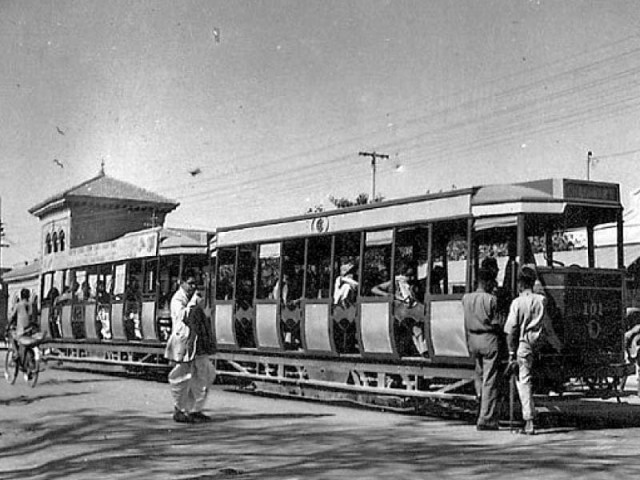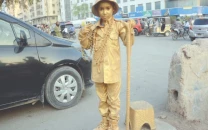A case for trams in jostling Karachi
Introduction of trams is a continuation of space sharing culture that would inherently promote urban tolerance

Nostalgic for the Karachi in the 1950s, many have argued for a tram service to be initiated in Karachi to mitigate its transport issues. PHOTO: COURTESY AIRFHASAN.ORG
Recalling his memories, according to media reports, he winnowed several urban planning issues while discussing life in Karachi during his stay here. Looking into the rationality of using trams in the cosmopolitan city, Mr Arbuckle's argument merits attention because of his practical experience of living in the port city. Introducing trams in Karachi must, however, address practical urban challenges as was done by many smart cities of the world.
New York, for example, started operating low floor trams as early as 1912. Their floors were intentionally kept low because women in New York, at that time, would wear hobble skirts which were quite narrow below the knees. The purpose was to intelligently facilitate the women to easily board and disembark from the tram. As a result, these trams in New York were called 'hobble skirt cars', reflecting their popularity in a major urban city. The use of similar trams was later extended to several parts of the US and Europe as the two regions had identical hobble skirt culture.
Keeping it local
The example underlines the critical importance of local challenges and cultural values in designing a tram system in a big city. If similar hobble skirt cars, for example, are introduced in a city like Karachi, where people predominantly use loose dresses, they may not attract as many people as it did in case of the US and Europe. It is because the cultural issues of New York and Karachi are poles apart.
This dimension is corroborated by a Japanese researcher Shigenori Hattori who, in a 2004 article, outlines the ups and downs of the use of trams in several big cities of the world. He argues that the use of trams must open the gateways to urban renewal.
The first urban transport system of the world, based on light rail transit, was sanguinely introduced in Canada's city, Edmonton, in 1978. Following gradual vicissitude, such systems were introduced in 70 cities across the globe in next 25 years. Till 2004, according to Shigenori, 350 tram systems were introduced in different cities of the world after carrying out necessary modifications and refurbishments. This suggests that developing a tram system through wily modifications, as per local requirements, is the real challenge requiring necessary innovation before trams are introduced in Karachi.
Planning for Karachi
Against this backdrop, an analysis of the Karachi Strategic Development Plan 2020's vacillating vision reveals three rudimentary factors on which it is based: transforming Karachi into a world class city, making it an attractive economic centre, and providing a decent life to the people of Karachi.
All three factors are fundamentally conjoined with the notion of urban renewal countering multiple externalities. Many of the urban challenges posed by these externalities have been investigated in detail by the Dutch scholar, Dr Jan van der Linden.
Dr Linden's work on low-income settlements in Karachi may help design a tram system for the city, capable of opening the doors of urban renewal.
Sharing space
'Sharing space' and 'demonstrating tolerance', in my opinion, are the two fundamental soft factors that, among other determinants, can transform Karachi into a world class city and an attractive economic center. The vertical development of the city, in terms of high-rise buildings and prevalent flat dwelling, indicates a predominant 'space sharing culture' in the city.
Karachi’s BRT to be zero-emission bio-power transportation
The introduction of trams is a continuation of space sharing culture that would inherently promote urban tolerance. It is because the entrance of tram in Karachi's transport system would extract the boundaries of its right-of-way. That means it will create discipline, tolerance and respect for the rights of other transport modes.
These values can inculcate a deeper sense of transport stasis among the people of Karachi while travelling on roads. The same traffic culture can then dissipate in other cities of Pakistan.
A surfeit of single occupancy cars has literally jostled Karachi requiring intelligent transport interventions. The introduction of trams could be an effective option for the people of Karachi, provided their practical issues, causing urban torpor, are sufficiently addressed while designing the system.
Karachi mass transit project gets new name
Merely adopting other cities tram models for Karachi could be disastrous for its wanton urban transport. A Spartan disciplined and courteous traffic pattern on roads is indeed reflective of the progressive mindset necessary for transforming Karachi into a world class city. Once such traffic pattern is achieved, it would itself be a symbol that the city is an attractive economic center capable of countering trite urban externalities and providing people with a decent life style.
The writer is a civil servant, holding a PhD in Planning from Massey University, New Zealand.
Published in The Express Tribune, February 20th, 2019.



















COMMENTS
Comments are moderated and generally will be posted if they are on-topic and not abusive.
For more information, please see our Comments FAQ